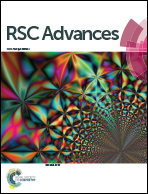Hyperbranched polyurethane as a highly efficient toughener in epoxy thermosets with reaction-induced microphase separation
Abstract
Hyperbranched polyurethane (HBPU), with flexible poly(tetrahydrofuran) segments between the branching points, was designed and prepared by a simple one-pot method. HBPU and the linear analog polyurethane (LPU) were used as tougheners in the diglycidyl ether of bisphenol A (DGEBA)/amine system, respectively. The HBPU was miscible with DGEBA resin without affecting the favorable processability of the epoxy blends. It was proved that a good phase separation structure with strong interface interaction was formed in the DGEBA/HBPU thermosets and the HBPU was more effective than LPU in toughening the epoxy resin. After adding 10 wt% HBPU, the impact strength of samples was 3 times as large as the neat epoxy. Meanwhile, the flexural strength and glass storage modulus of the thermosets were hardly affected with the addition of HBPU while obvious decreases were observed in the DGEBA/LPU thermosets. Especially, unlike most of the hyperbranched polymer tougheners, the introduction of HBPU also simultaneously improved the rubbery plateau modulus, glass-transition temperature and thermal stability of the epoxy thermosets.


 Please wait while we load your content...
Please wait while we load your content...